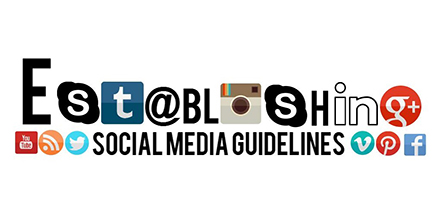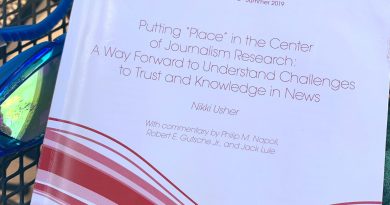Tips for creating a social media policy for your journalism program

[UPDATED: This post was updated 8.21.15 from its original post 6.18.15]
Despite what some educators may want, social media is not just a trend. It has slowly become a way of life. It is how the younger demographic consumes their news. News from friends. News from family. News from major media conglomerates. As scholastic journalism staffs across the world continue to use social media to share stories and inform their readers, social media policies must be put in place for two reasons: 1. Preventing bad things from happening and 2. Maximizing your effectiveness.
So where do we start?
Step One: Define your goals.
Almost every single piece of research on this topic insists that the first step to establishing guidelines for any social media usage is outlining your ultimate goal. What exactly do your staffers hope to achieve through their social media presence? This goal is twofold. You must consider both your staff and your readers. First, start with your staff. Social Media Explorers blogger Teddy Hunt suggests creating a list of things that staffers can do instead of creating prohibitive rules. He says by doing this your staff will feel less restricted and more willing to adhere to the guidelines established in the social media policy. So what type of strategic plan does your staff have in place already? Is your target audience just the student body? Are parents included? Faculty and staff? Other stakeholders in your community? At Bloomingdale High School in Valrico, Florida, adviser and social media teacher Heather Hanks said the target audience depends on the social media network.
“Tumblr is more directly for students, where Twitter is more community-oriented and Facebook is more for parents to share,” said Hanks.
The difference in target audience seems to hold true for most publications as Joe Humphrey’s publication staffs at Hillsborough High School in Tampa, Florida have learned.
“On Twitter it is current students,” Humphrey said. “On Facebook, we realize the users skew a bit older so more alumni there.”
This can help determine where you need to have a presence and if you should create unique posts to different accounts or simply link all accounts together and save time. For example, our Facebook page is linked to both our Instagram and Twitter accounts, but our audience on Facebook is primarily alumni and parents. Should we have a staff member, perhaps our business manager, create unique content for Facebook that would cater to reunion committees or conference nights? Another way to clearly outline your goals with social media is to revisit the publication’s mission statement. And if you don’t have one, you need to. Humphrey’s online staff at Hillsborough High School established its No 1. goal as driving traffic to their content.
“We run a fairly robust website, but analytics show it’s a bit like a tree in a forest,” said Humphrey. “So we use social media with the primary aim of getting eyeballs on HHSToday.com.”
The mission statement captures in just a few sentences the essence of your goals and the philosophies behind them. It allows all your stakeholders to know exactly what your publication is all about. Since it reflects every facet of your publication, it should be included in the social media policy created by your staff.
Step Two: Examine your school culture.
It is important to understand how both your staff and readers feel about social media in general. How is social media currently being used by students? By teachers? By administrators and parents? Are the accounts transparent? We currently have four teachers with active Twitter accounts that include regular engagement with students. These accounts are transparent so it is obvious who is posting content. Three of those are also athletic coaches. We also have four other fairly active accounts on campus that are not as transparent. Our football account is run by the head football coach. Our flag football account is the same way, though this is not as clear in the biography attached to the account. The official school account is content curated by our principal, but at one point in this account’s infancy stage I was asked to manage it. Our journalism program at Robinson High School in Tampa, Florida has two social media accounts with a commanding presence, a Twitter account and Humans of RHS Instagram account. Isabel Hanewicz, the online editor in chief, acted as an unofficial manager of both accounts in their infancy stage since the initial goal of Twitter was to drive traffic to that publication.
“We like to put out more news and announcements than the official school Twitter account so that we are the primary source of news for the school community,” Hanewicz said.
Although our journalism program’s account is currently managed by three to four students at most, with the adviser having access to it, the bio for this account reads that it is run by the students in the journalism program not one specific publication or editor. There was a point in time when multiple staff members had access to this account, but that changed after we were hacked. More on that later. If your publication’s account is not transparent, do you want to have staffers sign off when they post content on that account? That’s something to think about if it is important at your school site to know exactly who was responsible for a particular post.
Step Three: Organize a team.
It may seem obvious who should be on your team, but that may vary depending on what you found as you examined your school culture. Are your school publications a public forum or limited public forum, or are they held to the Hazelwood standard and prior review from your administration or other authority on campus? Include the adviser, student editors and at least one staff member. Beyond that, figure out a combination that works for you. As with all student publications or organizations, it is important to have involvement from a variety of staff members in order to help create ownership. Regardless of whether a beginning staffers are involved in your publication’s social media outreach, they should be included in the process. By involving staff members from all hierarchy levels, they will be more likely to embrace the guidelines that are created.
Step Four: Research.
Evaluate any current policies that may be in place by your school or district. For those staffs that already have an online presence, identify past successes and failures. As mentioned earlier, our journalism Twitter account was hacked. We had several staff members that had access to the account because we wanted to drive traffic to our online newspaper and we wanted more followers. Our password was accessible to anyone on staff. Neither student editors nor myself could remember exactly who all had access and had to assume that everyone did. Though the hacker only posted one message that stayed public for a few minutes before the staff realized it and deleted the post, fixed our cover photo, profile picture and bio, the message had over 30 favorites and a dozen retweets. We changed the password immediately and started damage control. Both Hanks and Humphrey have small number of staffers who have access to their publications’ social media accounts. Hanks has limited hers to just her yearbook editor-in-chief and the staffer in charge of that specific account. Humphrey advises more than one publication and controls access to the accounts a little different than Hanks. “About seven different people have access to our Twitter account,” Humphrey said. “We change the password every few months.”
After our hacking incident not only did we adopt similar policies, we contacted the administration and assured them we took care of the account, publicly apologized for the inappropriate content and contacted the student who was the target of harassment. This is also when Hanewicz and I decided we needed to create clear guidelines for our social media accounts.
“Earlier this year we had the same password for almost everything in journalism,” Hanewicz said. “[After our Twitter got hacked], I changed passwords and have tried to limit access as much as possible.”
In addition to establishing a media editorial policy for the online newspaper, it was evident our staff needed to be clear on how we would operate our social media outlets. But you don’t have to start from scratch. Examine other social media policies and guidelines from other media outlets, professional or scholastic.
Step Five: Rough draft and feedback.
Now that your team has had the opportunity to define goals and examine your school’s culture and research, it’s time to draft guidelines and get feedback from the rest of the staff and any other stakeholders you decide to include. As you begin to draft your guidelines, make sure to include the following: Mission statement, social media goals, a style guide, roles and responsibilities, external regulations, appropriate actions and best practices. Be specific in each of these areas. Information that is misunderstood will be nearly impossible to implement effectively. Write in a friendly tone and keep it short. Your publication staff is more likely to actually read something that is clear, succinct and in an easy-to-understand approachable tone. If you happen to be in a Hazelwood or prior review school, you may want to contact the person in charge of media relations to make sure you adhere to policies that are already in place.
Step Six: Introduce the guidelines to your staff.
Once you have taken the time to make any revisions that came from feedback, it’s time to share the final draft with your publication staff. Take the time to make sure every member of the staff understands and can adhere to the guidelines that have been established. Hanewicz said it is important to operate our social media accounts the same way professional news outlets would or better.
“All of our staffers that have access to our accounts have personal social media accounts,” she said. “But know they must act [and post] differently on the journalism ones. Even the big news organizations have problems with getting too wrapped up in social media and tweeting news too early or tweeting something they saw on social media that turned out not to be true.”
If you have a shared social media account that is used by multiple publications, task editors of those publications with explaining and implementing the guidelines for their specific publication. We currently have one Twitter account that is used to share all publication news. This is directly linked to our Facebook page to reach our audience of alumni and parents that may not be using Twitter, like my mom. The same thing applies to our Instagram account that is used for our Humans of RHS profiles. But as our publications grow and evolve year to year, or even semester to semester, this could change, which leads us to the final step.
Step Seven: Review periodically.
Social media evolves every day. When I first began researching this topic, no one knew what Snapchat was. Today, the students in my classroom are using Snapchat more than Twitter and Instagram combined. We are currently testing Snapchat as a way of generating sales for yearbook, providing snippets of event coverage with a plug to check out the story later online and getting information to students. And it’s only been a few months. This would be great to do at the end of each semester for newspapers or broadcast and after final deadlines for yearbook staffs or literary magazines. Hanks’ yearbook staff at Bloomingdale did not start by going directly to social media when they went digital, because their focus was curating an audience. Hanks’ staff has built that audience and wants to maintain it.
“Now it’s become about using social media and other creative methods for our audience to consume content,” Hanks said. “Their needs have changed how we create content, and social media what the catalyst for that change.”
Humphrey discovered that social media seemed to be an afterthought with his publication staffs and recently created a position to have one person in charge of their social media.
“We wanted to put one senior-level person, equal in status to an EIC, in charge of it in recognition of its importance to our overall strategy,” Humphrey said.
Social media is a powerful tool that can enhance communication with your audience. It can also be a disaster if guidelines are not put in place with the same ethical principles you have in place for your publication staff. And if you have access to multiple Twitter accounts on your mobile device you have to take extra precautions. Humphrey knows this first hand.
“Be careful which account you’re tweeting from,” Humphrey said. “Even I’ve sent something meant to be from me from HHSToday by accident, so be extra careful about which one is logged in on your device.”
Guidelines are not necessarily one size fits all either. While many social media policies will have areas of overlap, it is important to create a policy that fits the unique composition of your staff and audience, while still upholding three basic ethical principles: act independently, seek and report the truth and minimize harm. Hanewicz said even though some schools have a social media policy already in place for students, it is still necessary for scholastic publications to have one of their own.
“Your staff need to have a clear set of rules so that anyone with access to the account knows how to maintain a professional news presences while using the account,” she said. “While you want to gain a bigger audience and expand your reach, don’t sacrifice your journalistic values for a few retweets or likes.”
Check out these social media policies as you create one for your staff.
- Professional Publication
Social Media Guidelines for AP Employees | Associated Press.
http://www.ap.org/Images/Social-Media-Guidelines_tcm28-9832.pdf
- Collegiate Publication
Social Media Guidelines for Student Journalists | ASU Walter Cronkite School of Journalism
http://cronkite.asu.edu/social-media-guidelines
- High School Publication
Regarding Social Media | FHNToday.com
http://fhntoday.com/editorialpolicy/ [Scroll to section Q.]
Sources:
HOW TO SET UP SOCIAL MEDIA GUIDELINES FOR YOUR STAFF: 8 simple rules that will benefit both you and your staff. Teddy Hunt, Social Media Explorer
The Complete Guide to Developing a Social Media Policy for Your Business.
Casandra Campbell, Social Media Today
Social Media Guidelines | NYC Department of Education
NYC Department of Education




Pingback:Social Media Policies for Marketing Class « Kimberly L. Davis EdTech Learning Log
Pingback:5 Things Your Staff Should Be Doing If You Have A Social Media Presence | JEADigitalMedia.org